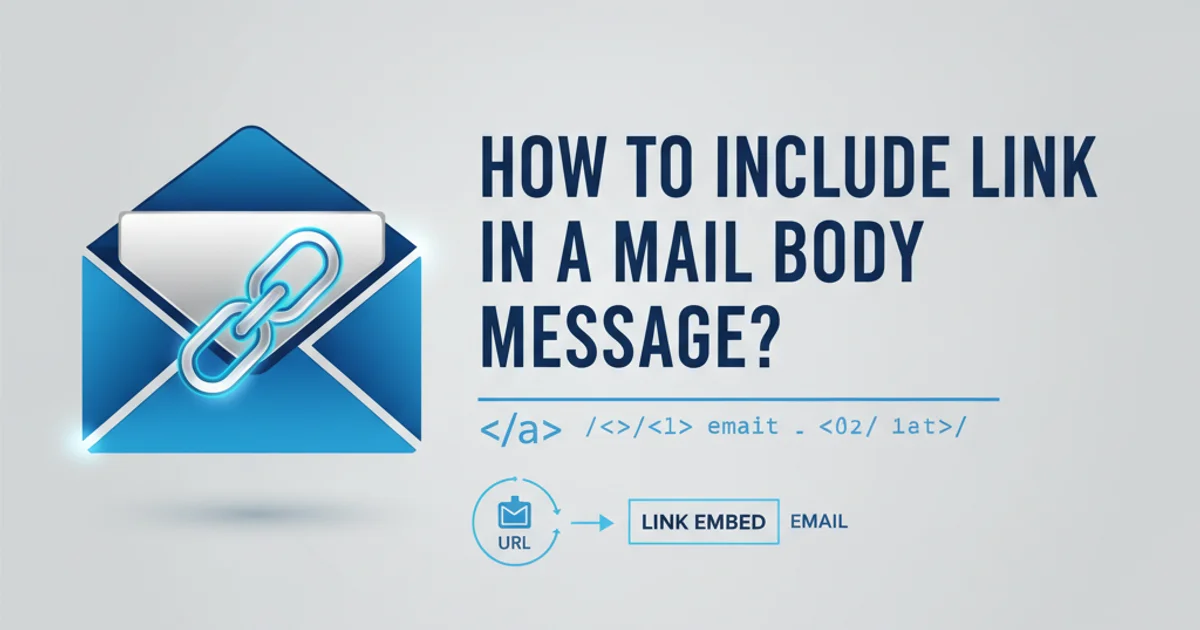How to include link in a mail body message?
Categories:
Embedding Hyperlinks in Email Body Messages with C#

Learn how to programmatically include clickable hyperlinks within the body of an email using C# and the .NET framework, focusing on SmtpClient and MailMessage.
Sending emails programmatically is a common task in many applications, whether for notifications, password resets, or marketing campaigns. Often, these emails need to contain clickable links that direct users to specific web pages or resources. This article will guide you through the process of embedding hyperlinks in the body of an email using C# within the .NET framework, specifically targeting Visual Studio 2013 and later versions. We'll cover both plain text and HTML email bodies.
Understanding Email Body Formats
Before diving into the code, it's crucial to understand the two primary formats for email bodies: plain text and HTML. Each has its own way of handling hyperlinks.
- Plain Text: In a plain text email, a URL is typically displayed as raw text. While many email clients automatically detect and make these URLs clickable, you cannot embed a link within other text (e.g., 'Click here'). The URL itself must be visible.
- HTML: HTML emails offer much greater flexibility. You can use standard HTML
<a>tags to create rich, formatted links where the clickable text can be different from the actual URL. This is the preferred method for professional-looking emails.
flowchart TD
A[Start Email Creation] --> B{Choose Body Format?}
B -->|Plain Text| C[Set MailMessage.IsBodyHtml = false]
C --> D[Append Raw URL to Body]
B -->|HTML| E[Set MailMessage.IsBodyHtml = true]
E --> F[Construct HTML <a> Tag]
F --> G[Append HTML to Body]
D --> H[Send Email]
G --> HDecision flow for embedding links based on email body format.
Embedding Links in Plain Text Emails
For plain text emails, you simply include the full URL directly in the message body. Most modern email clients will automatically render this as a clickable link. While straightforward, this method lacks the aesthetic appeal and flexibility of HTML emails.
using System.Net.Mail;
using System.Net;
public class EmailSender
{
public static void SendPlainTextEmailWithLink(string recipientEmail, string subject, string linkText, string url)
{
try
{
using (MailMessage mail = new MailMessage())
{
mail.From = new MailAddress("your_email@example.com");
mail.To.Add(recipientEmail);
mail.Subject = subject;
mail.Body = $"Hello,\n\nPlease visit our website: {url}\n\nThank you.";
mail.IsBodyHtml = false; // Important for plain text
using (SmtpClient smtpClient = new SmtpClient("smtp.example.com", 587))
{
smtpClient.Credentials = new NetworkCredential("your_email@example.com", "your_password");
smtpClient.EnableSsl = true;
smtpClient.Send(mail);
Console.WriteLine("Plain text email sent successfully!");
}
}
}
catch (Exception ex)
{
Console.WriteLine($"Error sending plain text email: {ex.Message}");
}
}
}
// Example Usage:
// EmailSender.SendPlainTextEmailWithLink("recipient@example.com", "Plain Text Link Test", "Our Website", "https://www.example.com");
C# code to send a plain text email with a raw URL.
https://www.example.com) to maximize compatibility across different email clients.Embedding Links in HTML Emails
For a more professional and user-friendly experience, HTML emails are the way to go. You can use the standard HTML <a> tag to create clickable text. This allows you to control the appearance of the link and embed it naturally within your message content.
using System.Net.Mail;
using System.Net;
public class EmailSender
{
public static void SendHtmlEmailWithLink(string recipientEmail, string subject, string linkText, string url)
{
try
{
using (MailMessage mail = new MailMessage())
{
mail.From = new MailAddress("your_email@example.com");
mail.To.Add(recipientEmail);
mail.Subject = subject;
// Construct the HTML body with an <a> tag
string htmlBody = $"<html><body><p>Hello,</p><p>Please <a href=\"{url}\">click here</a> to visit our website.</p><p>Thank you.</p></body></html>";
mail.Body = htmlBody;
mail.IsBodyHtml = true; // Crucial for HTML content
using (SmtpClient smtpClient = new SmtpClient("smtp.example.com", 587))
{
smtpClient.Credentials = new NetworkCredential("your_email@example.com", "your_password");
smtpClient.EnableSsl = true;
smtpClient.Send(mail);
Console.WriteLine("HTML email sent successfully!");
}
}
}
catch (Exception ex)
{
Console.WriteLine($"Error sending HTML email: {ex.Message}");
}
}
}
// Example Usage:
// EmailSender.SendHtmlEmailWithLink("recipient@example.com", "HTML Link Test", "click here", "https://www.example.com");
C# code to send an HTML email with a clickable link.
Configuring SmtpClient for Sending Emails
Regardless of whether you send plain text or HTML emails, the SmtpClient class is responsible for sending the email. You'll need to configure it with your SMTP server details, credentials, and SSL settings. The example code uses common settings for many SMTP servers, but these may vary depending on your email provider.
1. Instantiate SmtpClient
Create a new instance of SmtpClient, providing the SMTP server address and port number. Common ports are 25, 587 (for TLS/SSL), or 465 (for SSL).
2. Set Credentials
Provide your email account's username and password using NetworkCredential. This is necessary for authentication with the SMTP server.
3. Enable SSL/TLS
Set EnableSsl = true if your SMTP server requires a secure connection, which is highly recommended for security.
4. Send MailMessage
Call the Send() method of the SmtpClient instance, passing your configured MailMessage object.